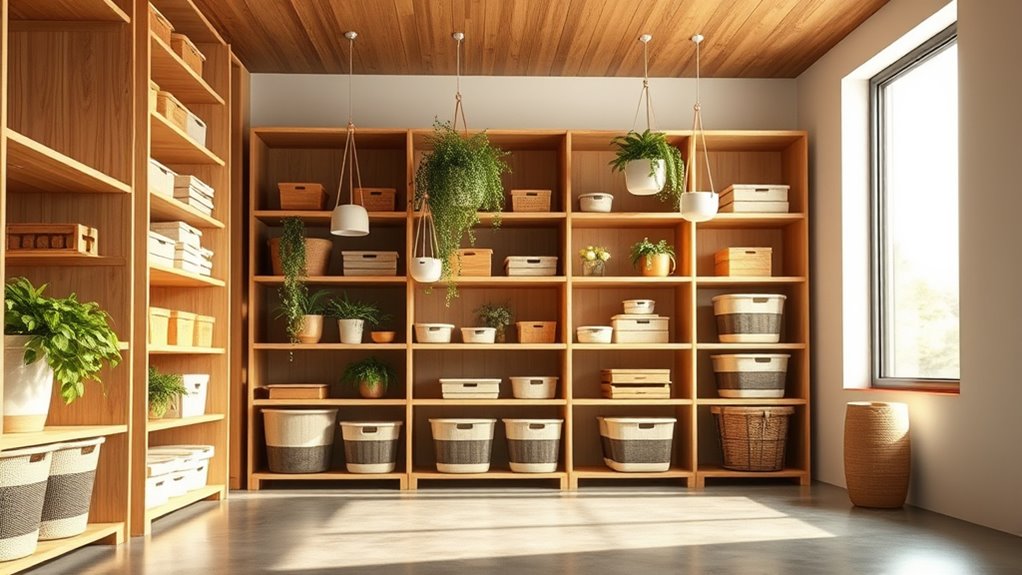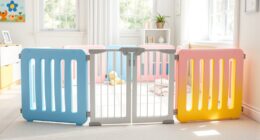Sustainable storage solutions focus on eco-friendly materials like recycled steel, reclaimed wood, and biodegradable plastics to reduce waste and conserve resources. They incorporate energy-efficient design features such as LED lighting, proper insulation, and smart ventilation to lower energy use. Optimized layouts and modular shelving maximize space and support long-term sustainability goals. Integrating renewable energy sources like solar panels enhances eco-friendliness. Keep exploring to discover how these strategies can transform your storage practices sustainably.
Key Takeaways
- Use recyclable and biodegradable materials like recycled steel, reclaimed wood, and eco-friendly plastics for storage solutions.
- Incorporate energy-efficient features such as LED lighting, insulation, and smart ventilation to reduce energy consumption.
- Optimize layout with modular, sustainable shelving to maximize space and minimize environmental impact.
- Integrate renewable energy sources, like solar panels, to power storage facilities and lower carbon emissions.
- Adopt sustainable practices by emphasizing durability, resource conservation, and circular economy principles in storage design.

As more organizations seek environmentally friendly ways to manage their inventory, sustainable storage solutions are becoming increasingly important. You can make a significant impact by choosing options that prioritize recyclable materials and energy-efficient designs. These choices not only reduce your carbon footprint but also promote a more responsible approach to resource management. When selecting storage units, look for those made from recyclable materials like recycled steel, reclaimed wood, or biodegradable plastics. These materials can be repurposed or recycled at the end of their lifespan, minimizing waste and conserving natural resources. By opting for such materials, you contribute to a circular economy that values reuse and sustainability.
Energy-efficient designs are equally crucial in creating a greener storage environment. Modern storage solutions incorporate features such as LED lighting, insulation, and efficient ventilation systems that lower energy consumption. For example, installing LED lights in storage areas ensures bright illumination with minimal power use. Insulation helps maintain stable temperatures, reducing the need for heating or cooling, which can be energy-intensive processes. Ventilation systems with energy-saving fans ensure proper airflow without excessive power draw. These design elements work together to cut down your facility’s energy costs while reducing greenhouse gas emissions. Additionally, incorporating vetted storage options can ensure quality and durability, aligning with sustainable practices.
Implementing sustainable storage solutions also involves considering layout and organization. Optimized shelving and modular units allow you to maximize space, reducing the need for additional storage facilities. This approach decreases the overall environmental impact of your storage infrastructure by making better use of existing space. Additionally, choosing modular, recyclable shelving units makes it easier to adapt or relocate storage setups without wastefulness. This flexibility supports your long-term sustainability goals and reduces landfill contributions.
Furthermore, integrating renewable energy sources like solar panels can power your storage systems, further enhancing their eco-friendliness. Solar energy can offset the electricity used for lighting, climate control, and other operations, making your storage facility more self-sufficient and less dependent on fossil fuels. Coupled with energy-efficient designs, solar power creates a holistic approach to sustainable storage that minimizes environmental impact while maintaining efficiency and productivity.
Frequently Asked Questions
What Materials Are Most Eco-Friendly for Storage Containers?
You should choose biodegradable plastics and bamboo storage for eco-friendly options. Biodegradable plastics break down naturally, reducing pollution, while bamboo is a highly renewable resource that grows quickly without chemicals. Both materials are durable and safe for storing items, making them excellent sustainable choices. By opting for these materials, you help minimize environmental impact and promote greener living, ensuring your storage solutions are both functional and eco-conscious.
How Can Storage Solutions Reduce Energy Consumption?
You might think storage solutions can’t impact energy use, but they can substantially reduce consumption through energy-efficient innovations. By choosing items designed with eco-conscious design principles, you minimize unnecessary energy waste. Properly organized storage minimizes clutter, reducing the need for additional lighting or climate control. Incorporating smart, energy-aware storage options helps you save power, making your space more sustainable while maintaining functionality.
Are Recycled Materials as Durable as New Ones?
Recycled materials can be just as durable as new ones, depending on the recycling processes used. You should look for materials that undergo quality control measures to guarantee their strength and longevity. Properly processed recycled materials often have comparable material longevity to new products, making them a reliable choice for storage solutions. When you choose recycled options, you’re supporting sustainability without sacrificing durability or performance.
What Is the Lifespan of Sustainable Storage Products?
You’ll find that sustainable storage products typically last between 5 to 15 years, depending on the material durability and usage. Did you know that high-quality recycled materials can match the lifespan of new ones? By choosing durable materials, you guarantee a longer product lifespan, reducing waste and environmental impact. So, investing in well-made sustainable storage solutions means you get reliable, eco-friendly storage that stands the test of time.
How Do Sustainable Storage Options Compare in Cost?
Sustainable storage options generally cost more upfront but offer better eco friendly pricing over time. You’ll find a positive cost comparison because they reduce energy bills and maintenance costs. While initial investments might seem higher, the long-term savings and environmental benefits make them worthwhile. By choosing eco-conscious solutions, you support sustainability and often access incentives or rebates, making the overall investment more affordable and aligned with your eco-friendly values.
Conclusion
By embracing sustainable storage solutions, you become a guardian of the planet’s future. Each eco-friendly choice is like planting a seed of hope, nurturing a greener tomorrow. When you prioritize sustainability, you’re weaving a vibrant tapestry of change—each action a colorful thread in the fabric of a healthier Earth. Together, you can turn the tide, transforming clutter into clarity and waste into wonder. Your commitment lights the way toward a brighter, greener world.









